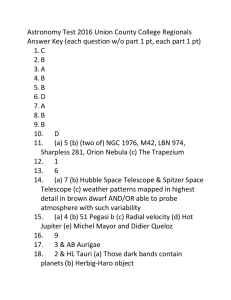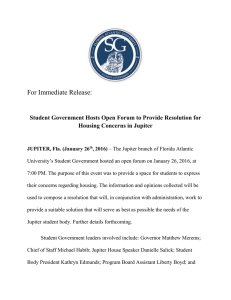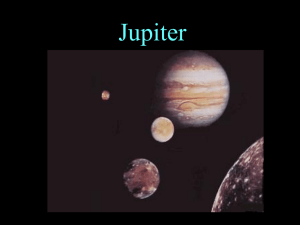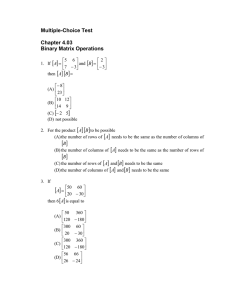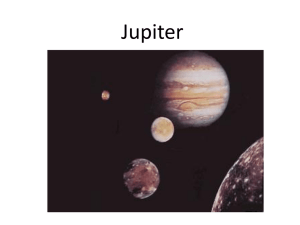Solutions to problem set 5
advertisement
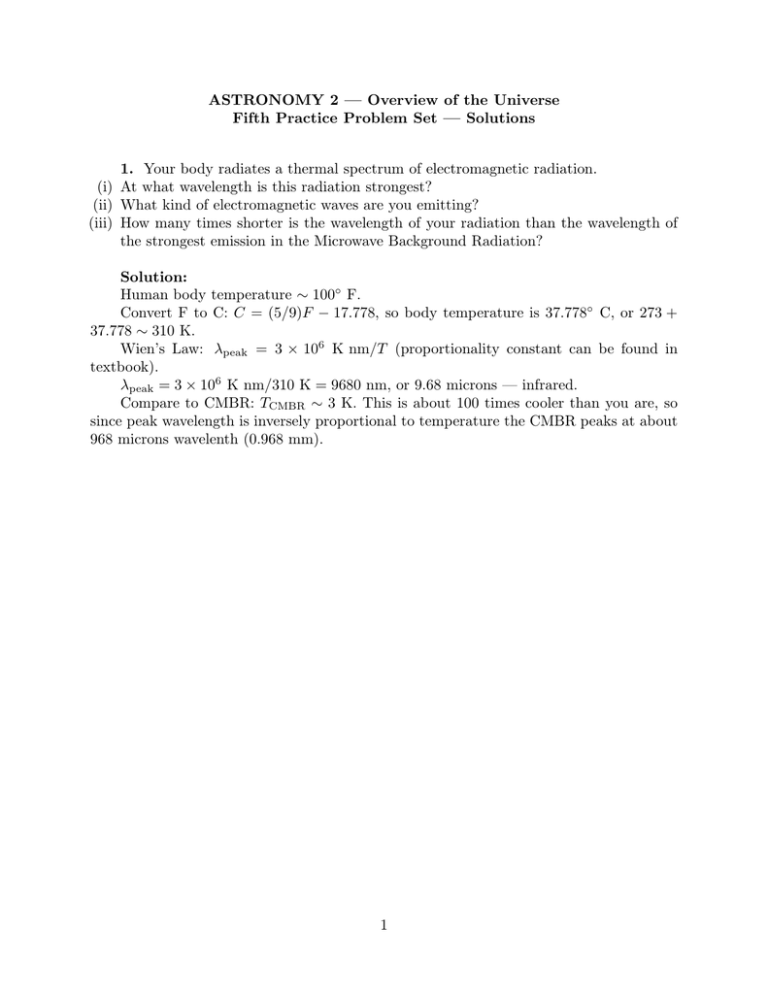
ASTRONOMY 2 — Overview of the Universe Fifth Practice Problem Set — Solutions 1. Your body radiates a thermal spectrum of electromagnetic radiation. (i) At what wavelength is this radiation strongest? (ii) What kind of electromagnetic waves are you emitting? (iii) How many times shorter is the wavelength of your radiation than the wavelength of the strongest emission in the Microwave Background Radiation? Solution: Human body temperature ∼ 100◦ F. Convert F to C: C = (5/9)F − 17.778, so body temperature is 37.778◦ C, or 273 + 37.778 ∼ 310 K. Wien’s Law: λpeak = 3 × 106 K nm/T (proportionality constant can be found in textbook). λpeak = 3 × 106 K nm/310 K = 9680 nm, or 9.68 microns — infrared. Compare to CMBR: TCMBR ∼ 3 K. This is about 100 times cooler than you are, so since peak wavelength is inversely proportional to temperature the CMBR peaks at about 968 microns wavelenth (0.968 mm). 1 2. (i) Jupiter takes 11.86 years to orbit the Sun. Use this fact to estimate Jupiter’s maximum distance from the Earth, and its minimum distance from the Earth. Solution: Kepler’s Third Law: P 2 = CR3 /M where C is a constant. First, find R. Take the ratio of Jupiter to Earth: (PJ /PE )2 = (RJ /RE )3 (the constant and the mass of the sun are the same for both equations) RJ = (PJ /PE )2/3 RE = (11.86/1)2/3 AU = 5.2 AU. Nearest and furthest approach occur when Jupiter, Earth, and the Sun are all on a line, with the planets on the same or opposite sides of the Sun respectively. dmax = 5.2 + 1 = 6.2 AU; dmin = 5.2 − 1 = 4.2 AU (ii) Jupiter has .001 times the mass of the Sun. The orbit of the moon Callisto around Jupiter takes approximately 16 days to complete. Estimate the maximum angle that you could observe Callisto separated from Jupiter on the sky. Solution: Take ratio of Callisto around Jupiter to Earth around Sun: (PC /PE )2 = (RC /RE )3 (M⊙ /MJ ) RC = (PC /PE )2/3 (MJ /M⊙ )1/3 RE RC = (16 days/365 days)2/3 (0.001 M⊙ /1 M⊙ )1/3 AU RC = (0.044)2/3 (0.001)1/3 = 0.12 × 0.1 = 0.012 AU Maximum angle on the sky occurs when the angle from Callisto to Jupiter to Earth is 90 degrees. From basic geometry, the angle between the Earth–Callisto and Earth–Jupiter sides of this right triangle is: θ = arctan(dCJ /dJE ) where dCJ is the distance from Callisto to Jupiter and dJE is the distance from Jupiter to Earth. We just calculated dCJ = 0.012 AU, and part (i) yields the range of possible dJE , between 4.2 and 6.2 AU. The angle will be greatest when dJE is smallest, so: θ = arctan(0.012/4.2) = arctan(0.0029) = 0.16◦ or 0.0029 radians (Note that one could have used the small angle approximation θ ≈ dCJ /dJE here). Put in more relevant units, 0.16◦ × (60′ /1◦ ) = 9.8′ (arcminutes) 2 3. The Sun will reside on the Main Sequence for 1010 years. The Main Sequence lifetime of a star is proportional to the star’s mass divided by the star’s luminosity. If the luminosity of a main-sequence star is proportional to the fourth power of the star’s mass, what mass star is just now leaving the main sequence in a cluster of stars that formed: (i) 400 million years ago. (ii) 2 billion years ago. Solution: t ∼ M/L and L ∼ M 4 , so t ∼ M/M 4 = M −3 Take the ratio with the Sun: t/t⊙ = (M⊙ /M )3 M = (t⊙ /t)1/3 M⊙ (i) M = (1010 years/400 × 106 years)1/3 M⊙ M = (25)1/3 M⊙ = 2.9M⊙ (ii) M = (5)1/3 M⊙ = 1.7M⊙ 4. If a supernova is 1010 times as bright as the Sun, how far away would it have to be in order to appear as bright as the Sun in our sky? Express your answer in light years. Solution: f = L/(4πd2 ) L⊙ /4π(1 AU)2 = 1010 L⊙ /4πd2 d2 = 1010 AU2 d = 105 AU Convert to ly: 105 AU × (8min/AU) × (1hr/60min) × (1day/24hr) × (1yr/365day) = 1.5 light years 5. A 10-km radius neutron star is spinning 1000 times per second. Calculate the speed of a point on its equator, and compare it with the speed of light. Also, calculate the orbital speed of a particle in a circular orbit just above the surface, if the neutron star’s mass is 1.4 times the mass of the Sun. Solution: A point on the equator travels the circumference of the neutron star 1000 times per second. v = 2πr × 1000 1/s v = 2π × 10 km × 1000 1/s = 63, 000 km/s v/c = (63, 000 km/s)/(300, 000 km/s) = 21% of the speed of light Orbital speed: use Kepler’s Third Law to get the period. Pp = (Rp /RE )3/2 (M⊙ /Mp )1/2 years Pp = (10 km/(1.5 × 108 km))3/2 (1 M⊙ /1.4 M⊙ )1/2 years Pp = (6.67 × 10−8 )3/2 (0.71)1/2 = 1.7 × 10−11 × 0.85 = 1.5 × 10−11 years 1.5 × 10−11 years × (3.15 × 107 s/1 year) = 4.6 × 10−4 s. v = 2πr/Pp v = 2π × 10 km/(4.6 × 10−4 s) = 136, 000 km/s (0.45c) 3
